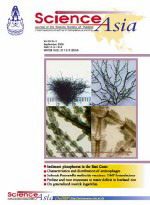ThaiScience
ThaiScience
SCIENCE ASIA
Volume 46, No. 05, Month OCTOBER, Year 2020, Pages 514 - 519
Anti-biofilm activity of thai herbal essential oils against staphylococcus pseudintermedius causing canine pyoderma
Jareerat Aiemsaard, Chuchart Kamollert, Ranee Singh, Pimchanok Suwannathada, Pongthorn Suwannathada, Eakachai Thongkham
Abstract Download PDF
The aim of this study was to investigate the efficacy of 11 essential oils (EOs) against Staphylococcus pseudintermedius planktonic and biofilm forms. Twenty three bacterial samples were collected from dogs with superficial pyoderma and 9 samples were identified as S. pseudintermedius by polymerase chain reaction-restriction fragment length polymorphism method. The minimum planktonic inhibitory concentration (MPIC), minimum planktonic bactericidal concentration (MPBC) and minimum biofilm eradication concentration (MBEC) of EOs were determined by broth microdilution using a transferable solid phase. Among all, lemongrass EO was the most effective against both planktonic and biofilm forms of S. pseudintermedius with the MPIC, MPBC and MBEC of 0.02, 0.039 and 0.078% v/v, respectively. EOs of betel vine and citronella had the second most inhibitory effect (MPIC and MPBC: 0.039% v/v and MPBC: 0.156% v/v) followed by clove (MPIC and MPBC: 0.078% v/v) and sweet basil (MPIC and MPBC: 0.625% v/v). The EOs of ginger, plai, kaffir lime, turmeric, holy basil and galanga had the lowest inhibitory effect with MPICs and MPBCs ranging from 1.25% v/v to greater than 2.5% v/v. The results of this study indicated that the anti-planktonic and anti-biofilm effects of the tested EOs were concentration dependent, and higher concentrations were required for anti-biofilm activity. Lemongrass EO showed the most potential as a therapeutic antimicrobial agent for both planktonic and biofilm forms of S. pseudintermedius.
Keywords
essential oils, Staphylococcus pseudintermedius, anti-biofilm activitySCIENCE ASIA
Published by : The Science Society of Thailand
Contributions welcome at : http://www.scienceasia.org/
